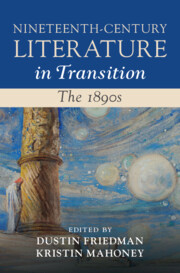Book contents
- Nineteenth-Century Literature in Transition: The 1890s
- Nineteenth-Century Literature in Transition
- Nineteenth-Century Literature in Transition: The 1890s
- Copyright page
- Contents
- Figures
- Contributors
- Acknowledgments
- Introduction
- Chapter 1 Race and Empire in the 1890s
- Chapter 2 Island Dandies, Transpacific Decadence, and the Politics of Style
- Chapter 3 The 1890s and East Asia: Toward a Critical Cosmopolitanism
- Chapter 4 Indulekha, or The Many Lives of Realism at the Fin de Siècle
- Chapter 5 Reading World Religions in the 1890s
- Chapter 6 Night Lights: The 1890s Nocturne
- Chapter 7 The Green 1890s:
- Chapter 8 “Only Nature Is a Thing Unreal”: The Anthropocene 1890s
- Chapter 9 Weird Ecologies and the Limits of Environmentalism
- Chapter 10 Queer Theories of the 1890s
- Chapter 11 Eugenics and Degeneration in Socialist-Feminist Novels of the Mid-1890s
- Chapter 12 The Conservative and Patriotic 1890s
- Chapter 13 Decadence and the Antitheatrical Prejudice
- Chapter 14 Religion and Science in the 1890s
- Chapter 15 Little Magazines and/in Media History
- Chapter 16 Fin-de-Siècle Visuality (and Textuality) and the Digital Sphere
- Index
Chapter 10 - Queer Theories of the 1890s
Published online by Cambridge University Press: 17 August 2023
- Nineteenth-Century Literature in Transition: The 1890s
- Nineteenth-Century Literature in Transition
- Nineteenth-Century Literature in Transition: The 1890s
- Copyright page
- Contents
- Figures
- Contributors
- Acknowledgments
- Introduction
- Chapter 1 Race and Empire in the 1890s
- Chapter 2 Island Dandies, Transpacific Decadence, and the Politics of Style
- Chapter 3 The 1890s and East Asia: Toward a Critical Cosmopolitanism
- Chapter 4 Indulekha, or The Many Lives of Realism at the Fin de Siècle
- Chapter 5 Reading World Religions in the 1890s
- Chapter 6 Night Lights: The 1890s Nocturne
- Chapter 7 The Green 1890s:
- Chapter 8 “Only Nature Is a Thing Unreal”: The Anthropocene 1890s
- Chapter 9 Weird Ecologies and the Limits of Environmentalism
- Chapter 10 Queer Theories of the 1890s
- Chapter 11 Eugenics and Degeneration in Socialist-Feminist Novels of the Mid-1890s
- Chapter 12 The Conservative and Patriotic 1890s
- Chapter 13 Decadence and the Antitheatrical Prejudice
- Chapter 14 Religion and Science in the 1890s
- Chapter 15 Little Magazines and/in Media History
- Chapter 16 Fin-de-Siècle Visuality (and Textuality) and the Digital Sphere
- Index
Summary
There’s an incoherence in our thinking about the intersections of gender and sexuality in the 1890s that is conditioned by an overemphasis on the Oscar Wilde trials. 1895 saw the coalescing of diffuse components (aestheticism, dandyism, effeminacy) that would establish a modern definition of male homosexuality. Yet we recognize that Wilde had little interest in the sexological notion of inversion, advocating instead for the pederastic model that depended on the repudiation of cross-gender expression. This chapter reconsiders the legacies of the 1890s by shifting focus from Wilde to two figures who differently adjudicated the merits of pederasty and inversion: John Addington Symonds and Edward Carpenter. Analyzing the revisions Carpenter made to his pamphlets in preparation for the publication of Love’s Coming-of-Age – delayed by Wilde’s trials – the chapter shows the influence of Continental thinkers such as Ulrichs and Hirschfeld, as well as New Woman writers of the 1890s, in defusing the antagonism between pederasty and inversion.
- Type
- Chapter
- Information
- Nineteenth-Century Literature in Transition: The 1890s , pp. 208 - 226Publisher: Cambridge University PressPrint publication year: 2023

